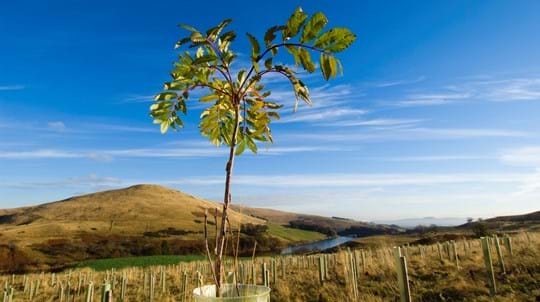
Credit: Nature Photographers Ltd / WTML
Leaves
The leaves are shiny and slightly waxy, and have tiny sharp teeth along the edges. They turn a rich orange-red before falling in autumn.
Industrious, delicate, colourful. The spindle is at its loveliest in autumn when its leaves turn russet and its pink and orange fruits ripen. Wildlife loves its leaves and fruit, and aphids flock to it, bringing with them an array of their predators.
Common name: spindle
Scientific name: Euonymus europaeus
Family: Celastraceae
Origin: native
Spindle is a deciduous native tree, and mature trees grow to 9m and can live for more than 100 years. The bark and twigs are deep green, becoming darker with age, and have light brown, corky markings. Twigs are thin and straight.
Identified in winter by: the vivid pink fruits which have bright orange seeds. Buds and twigs are angular and green.

Credit: Nature Photographers Ltd / WTML
The leaves are shiny and slightly waxy, and have tiny sharp teeth along the edges. They turn a rich orange-red before falling in autumn.

Credit: Nature Photographers Ltd / WTML
Spindle is hermaphrodite, meaning each flower contains both male and female reproductive parts. Flowers have four petals and grow in clusters in May and June, and are pollinated by insects.

Credit: Nature Photographers Ltd / WTML
After pollination, flowers develop into bright pink fruits with bright orange seeds, which look a bit like popcorn.
Dogwood (Cornus sanguinea) when the spindle is in leaf.
Spindle is native to much of Europe and can be found most commonly on the edges of forests and in hedges, scrub and hedgerows. It thrives in chalky soils and is less common in Scotland.

Spindle is an ancient-woodland indicator. If you spot it while you're out exploring, it could be a sign you're standing in a rare and special habitat.
Learn more about ancient woodland
Credit: Gary K. Smith / naturepl.com
The leaves are eaten by caterpillars of moths, including the magpie, spindle ermine and scorched, as well as the holly blue butterfly. The leaves also attract aphids and their predators, including hoverflies, ladybirds and lacewings, as well as the house sparrow and other species of bird.
The flowers are a rich source of nectar and pollen for insects such as the St Mark’s fly.
The spindle’s botanical name, Euonymus, is from the Greek ‘eu’, meaning ‘good’ and ‘onoma’, meaning ‘name’. This is said to have meant ‘lucky’. However, in some areas, it was also thought that if the spindle flowered early, an outbreak of the plague was on the way.
Spindle timber is creamy-white, hard and dense. In the past it was used to make ‘spindles’ for spinning and holding wool (hence its name), as well as skewers, toothpicks, pegs and knitting needles.
The fruits were baked and powdered, and used to treat head lice or mange in cattle. Both the leaves and fruit are toxic to humans – the berries having a laxative effect.
Today, spindle timber is used to make high-quality charcoal for artists. Cultivated forms of the tree are also grown in gardens for autumn colour.

Helen Keating • 05 Dec 2022
Transform your home into a woodland wonderland this Christmas with our easy ideas for festive, foraged home decor.
Be inspiredSpindle may be affected by vine weevil, spider mite and a sap-feeding scale insect, which can cause dieback.

Trees woods and wildlife
Our free Tree ID app for Android and iPhone helps you identify the UK's native and non-native trees. It's an A-Z tree guide in your pocket.

Shop
We have single trees and tree packs to meet your needs, from wildlife to woodfuel. Delivery is free.
External link